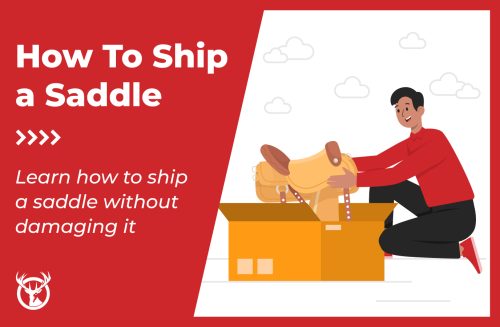Shipping live plants requires careful planning, proper packaging, and compliance with complex regulations.
Whether you’re doing ecommerce fulfillment for your plant store or just moving houseplants across state lines, successful plant shipping depends on understanding both legal requirements and proper handling techniques.
This comprehensive guide covers everything you need to know about shipping plants:
- Federal and state shipping regulations
- Carrier requirements and options
- Proper packaging methods for different plant types
- Temperature and moisture control
- Expert advice from professional plant shippers

TL;DR:
Key takeaways

Check USDA and state regulations before shipping plants – restrictions vary significantly by location and plant type, and some states, like California, have strict quarantine requirements.

Ship plants early in the week using expedited services—avoid weekends and holidays to prevent plants from sitting in warehouses and minimize transit time.

Pack plants with slightly moist (not wet) soil, wrap roots in damp newspaper or paper towels, and seal in plastic to maintain moisture during transit.

Remove plants from ceramic pots before shipping and use lightweight plastic containers to reduce shipping costs and prevent breakage.

Use waterproof labels marked “Live Plants,” “Perishable,” and “This Side Up”—standard paper labels can become unreadable from plant moisture.
Ask the USDA
Your first move to ship plants is to look at federal and state regulations. There are state-by-state rules for shipping plant cuttings through the mail, so you need to look at requirements from both your location and where customers live.
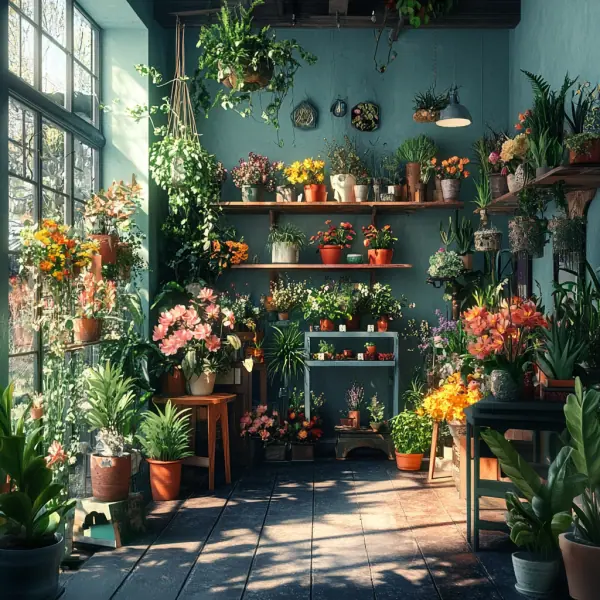
When you’ve got a carrier selected, reach out, and they can help you find the correct information and label your packages appropriately. Here are some early reading requirements that include plant shipping rules for how to ship plants:

Review general plant protection regulations, including restrictions, laws, rules, and acts that address pests

Check this United States Department of Agriculture database to see if the plant is prohibited or has other state-based limitations.

Read plant labeling and other information for shipping and imports.

Check state regulations directly from the states or third-party services

And ask your carrier for their information, such as this older letter from the USPS
Unfortunately, you’ll need to review every order. States have many different rules that may prevent some shipments because certain plants are banned, some face quarantine periods, and others may need to be inspected.
For example, California has some of the strictest regulations because of the importance of its agriculture industry. You can’t import any citrus plants into California, and certain other plants must be quarantined before they enter the state. However, shipping houseplants to California is fine as long as they’re grown indoors using sterile potting soil.
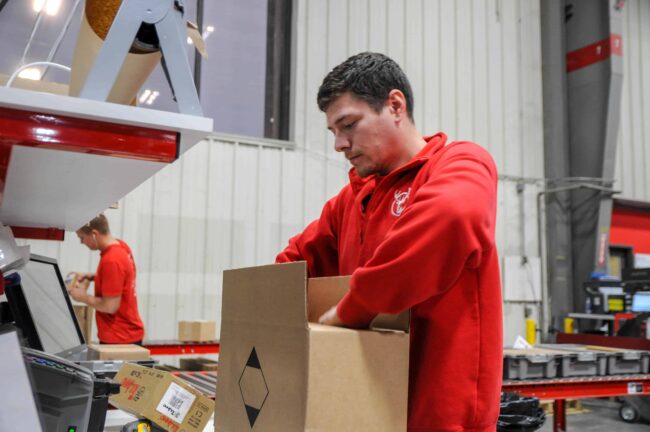
Who can ship plants and trees?
The three major carriers in the U.S. will help you ship plants and small greenery. Each has its own set of restrictions, but they generally follow the USDA guidelines. UPS and FedEx also offer packaging support specific to different plants.
Alex Kantor, plant expert and owner of Perfect Plants, a family run online nursery based out of North Florida sites an example of how UPS’s plant shipping regulations affect his nursery:

Some of our most popular plants being shipped are large fruit trees. These trees can scale upwards of 4-6 feet, 6 feet being the largest height we can ship. UPS has regulations for larger trees and can pack hefty fees for anything taller than 6 feet.
One method we’ve implemented to help these tall trees remain stable in their shipping boxes is by staking them in with tall bamboo rods to help immobilize the tree trunks and pot during a rough transit. This is a new practice for us and helps tremendously to reduce shipping damage.

Alex Kantor
Plant Expert and Owner Perfect Plants
How much does it cost to ship plants? The cost to ship live plants will vary significantly, from around $10 or $20 to hundreds of dollars, depending on the plants and package size, especially given the need to have these plants shipped quickly. Speak to your preferred carrier directly whenever you want to ship plants. That’s because shipping something over the weekend or using the wrong option could lead to your plants sitting in a warehouse or waiting in transit, potentially harming them.

PRO TIP: Put plants in the mail early in the week and avoid shipping house plants near holidays to minimize transit time.
Let your plants guide the fulfillment process.
Plants need speedy shipping
Plants need to move to their destination quickly. The younger the plant, the more fragile it is, in most cases. Many people and businesses ship younger plants because they’re also smaller and thus cost less.
In most cases, you’ll want to choose an expedited shipping method. Here are some speedy shipping options to protect your plants:
- USPS
Can you ship plants through USPS? Yes. Postal Service shipping options Priority Mail and Priority Mail Express will get products to their destination within two working days. Flat-rate priority can also be used for plants, though you’ll want to use it only at the beginning of the week. - UPS
Stick with this carrier’s Next Day Air service to ensure safety and delivery speeds. Some UPS Ground options can get plants to their destinations by the end of the next business day, but the carrier recommends its air services. - FedEx
The company suggests using its overnight services to ship plants safely. First Overnight, Standard Overnight, and Priority Overnight should do the trick, and FedEx will generally help you source packaging (or at least provide suggested requirements) to move your goods.
One UPS driver told us that you might want to consider shipping to the UPS or another carrier store nearest to the recipient. That may speed up your plant shipping because shipping company stores are often bulk stops, which also can minimize how much handling the package experiences.
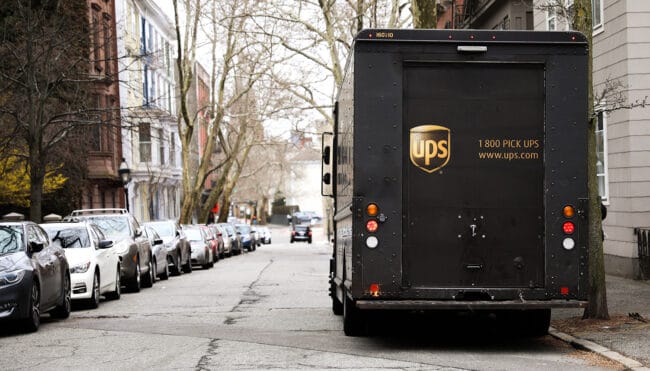
Pay attention to temperature and moisture
Packages need to be sealed up, but that can be problematic when sending plants in the mail. Small and young plants can live well without any holes for airflow, but mid-sized plants may need some. During cold weather, it’s not advisable to add holes to the shipping box, but you might need holes if you’re shipping plants in hot conditions.
Perhaps more important is matching temperature to your plants’ needs.

I would say 10% of the plants get damaged, either from weather or rough transit. We can’t do much about rough transit since that is luck of the draw.
But for weather-related damage – we do keep an eye on the weather during winter and if it is freezing temperatures somewhere in the country, we try to wait until the weather improves to ship it to that location. For heat related issues, we have poke holes in our boxes to allow for air flow.

Alex Kantor
Plant Expert and Owner Perfect Plants
Orchids and tropical plants may need insulation against cold temperatures. Others may need to maintain colder temperatures to avoid wilting during hot weather. Some packaging can help you prevent this, including cold or heat packs.
Secure the soil and stems of every plant you ship, whether they’re in pots or snipped for a flower arrangement. Wrap the roots in wet paper or paper towels to keep them moist, then wrap them in plastic to keep the moisture in and keep the soil in place. The amount of moisture in the packaging will depend on the time of year (temperature) and the type of plant. Succulents and cactuses should be shipped in semi-dry soil, so don’t water them before shipping.

PRO TIP: It’s generally easiest to remove potted plants from their pot before shipping, but don’t ship house plants with bare roots. Leave some of the soil on the roots when you pack the plant.
If you need strict temperature controls, ask carriers about services. Cold storage, temperature-controlled containers, and refrigeration trucks are available in most situations. Look for information from your carrier or 3PL if you work with a company like Red Stag Fulfillment.
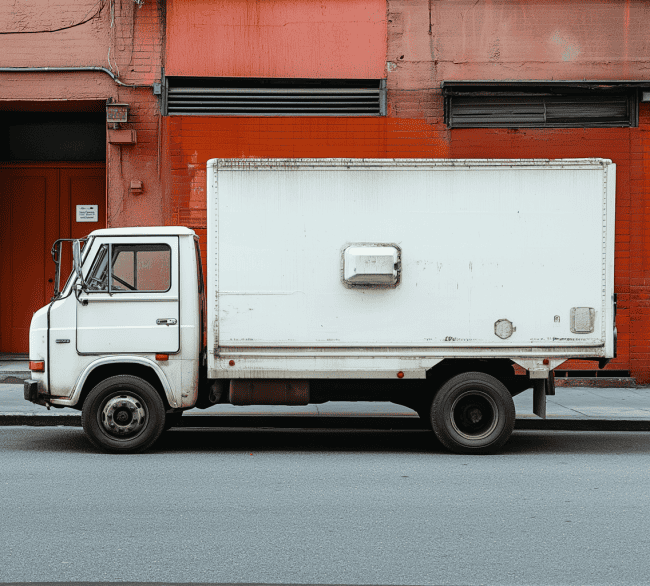
Steps to packing a plant
01
Water the plant anywhere from a few hours to a day before you ship it. You want the soil to be slightly moist when you send the plant.
02
Remove the plant from its pot, being careful not to damage the roots. Leave some of the soil on the roots. You can ship a plant in a pot, but shipping will be more expensive because of the extra weight, and the steps are slightly different. See above.
03
Wrap the root ball in damp newspaper or paper towels. If the plant will be in transit for several days, place some polymer moisture crystals inside the newspaper or paper towel (soak them in water first). You can also add more layers of damp paper or paper towels for more moisture. Wrap only the root ball in the damp paper, not the leaves.
04
Wrap the roots in plastic wrap or place them inside a plastic bag, being careful to keep the leaves outside the plastic.
05
Place your plant in a suitable box with inserts or packing material to protect your plant.
How to package plants for shipping
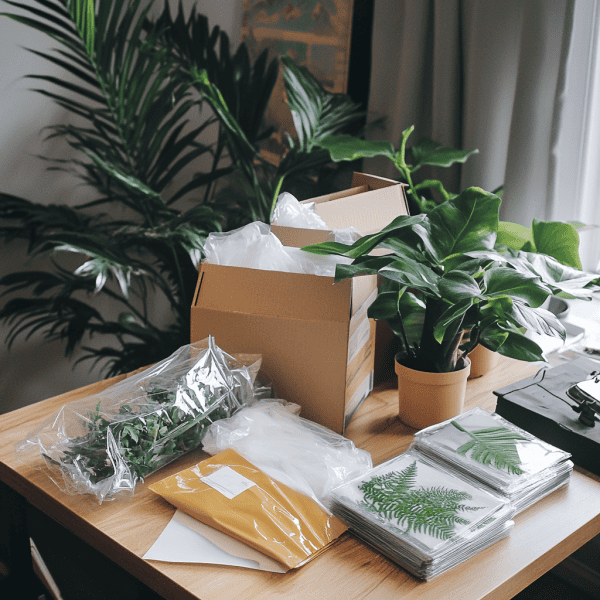
Is it safe to ship plants? Yes, though there are risks. However plants are shipped all of the time, and there are many ways to keep them safe. Many plants are lightweight, making it likely that you’ll be charged a dimensional (DIM) weight for the package. In general, that means you can pack your plants securely to minimize harm without worrying about significantly increasing the price. To keep them safe, here are some materials to consider:

Sturdy shipping boxes

Plastic bags and ties

Bubble wrap or air-filled bags

Packing paper

Lightweight or plastic pots (if you’re shipping plants in potted)

Sterilized soils

And a flea collar or two
If you’re sending plants for the first time, go to your local shipping company store and ask about what box options they have available. When it’s for your business, look at packaging companies that offer boxes specifically for plants. Corrugated boxes are your safest option for most plants because they’re easy to pack and strong enough to protect the fragile elements of plants.

A heavy-duty corrugated box is the best container for safely and affordably shipping plants. Boxes provide an ideal amount of structure around the plant while still being breathable, and there is a wide range of sizes to suit plants of various heights and widths.
Plants present a unique shipping challenge thanks to delicate stems that could snap and leaves that could get crushed. A plant also needs light to live, and spending too much time in a dark shipping box could weaken or even kill it. Temperature is another concern- tropical plants could die from cold exposure if you’re shipping to a northern location in the middle of winter.


Erinn Witz
Plant Expert and Co-Founder Seeds And Spades
Here are some options for different types of plant shipping.
Floral arrangements
Floral arrangement boxes have an area for you to secure the vase and cut flowers. Use rubber bands or twine ties to keep stems safe and pack them tightly within the box.
Bulk flowers
Select a corrugated, telescoping box that can fit your entire set of cut flowers or entire plants when laid down flat. You can add wood pieces like cleats to keep contents from shifting during transit, and corrugated box dividers (like the ones used to pack wine bottles) help shipments with multiple plants stay safe.
Wrap the stems in cool or wet paper to help keep your flowers alive and secure. Tape down the trays and telescoping elements to keep them in place while reinforcing the box structure.
How to ship potted plants

Most people ship plants without pots to minimize the cost of shipping, but there may be instances where it makes sense to ship houseplants or other types of plants in their pots.
If you’re shipping plants in pots or living arrangements in vases, look for a corrugated cardboard box with an internal divider or enough space for you to add one, similar to the dividers used to pack wine bottles. Wrapping the pot or vase in cardboard helps limit movement while protecting the container. Whether shipping large potted plants or small potted plants, make sure to securing the pot with cardboard minimizes shifting, hopefully preventing damage to plant stems and parts.
To ship plants in pots, you’ll also need cardboard inserts between the pot and the rest of the plant to keep the soil in place. Add “This Side Up” to the shipping label and arrows to prevent damage.

PRO TIP: Ship plants in a plastic pot to reduce the cost of shipping and the chance of breakage.
Shipping house plants bare roots versus being potted
There is a debate about whether house plants do better being shipped bare roots versus in pots. Many say large and small houseplants should be shipped without pots. There are others that say shipping plants bare roots is fine, but it’s very important to add good packaging around the roots, and that makes it fine. However, it can be just as common to see preferences on shipping house plants in pots, even though the shipping will be more expensive that way.
Bulk small plants
Sometimes you’ll ship a set of plants in a box. Here, you’ll want to get trays that are as close to the length and width dimensions of the box as possible. Open the box, place your tray inside, and line up the plants in the tray. Use packing paper and heavier materials between plastic trays or pots to limit movement.
When possible, use stackable corrugated trays that include top pads. Even if you’re not stacking them within the box, the stackable design makes it easier to pad the top of the box and limit harm to your plants. This type of setup is also useful for seedlings.
Seedlings
Shipping seedlings is common for eCommerce plant shops, but they’re fragile. Keep them safe by using boxes designed to fit the trays commonly used in greenhouses and stores during growing. Corrugated boxes offer reliable support, and you can wedge your plastic trays in safely. Adding a plastic mesh on top will help you protect small, leafy items and make it possible to stack multiple trays.
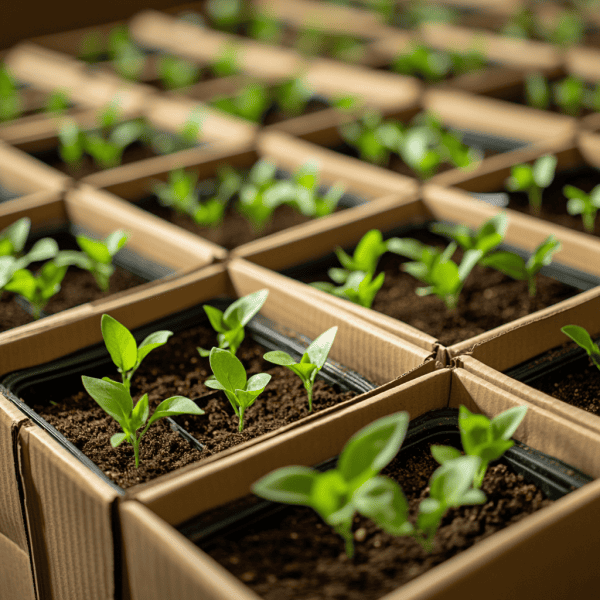
Orchids and delicate plants
Orchids, blooms, and other delicate items need special care. Look for shipping trays that have significant padding while also giving room for your plants. Wrap the leaves and blooms in paper to keep them safe. If your orchids are in pots, look for layers or trays with pre-cut inserts for the pots. Try to secure the pots and pack around them tightly — that’ll minimize impacts between blooms and other things in the box, limiting damage.
How to pack your plants
Plants are living things and can be sensitive to moves. Many indoor plants, flowers, and smaller plants will need to be carefully packed. Large plants, trees, and bushes must be carefully removed from the ground with roots and soil intact.
Large plants are often placed on a pallet with custom carpentry to prevent them from moving. The base will be wrapped in plastic if the branches are flexible and low to the ground. From there, the pallet is loaded onto a semi-truck and delivered directly to the home or business owner. Trees and plants shipped on pallets can easily weigh up to 500 lbs.
Labeling is a critical element of how to ship plants. Write the scientific and common names of your plant on the outside of each box and also add labels that say: “Live Plants,” “Perishable,” or “Fragile.”

PRO TIP: Don’t use paper labels because the moisture from the plant could render them unreadable.
Flower and small plant packing
If you’re shipping smaller plants, the process is a little easier, and you can use carriers like UPS, USPS, and FedEx instead of needing to find a semi. Here are the steps for these packages:
01
Prune your plants and remove dead elements up to a week before shipping.
02
If plants have a pot, change to lightweight plastic pots with sterilized soil.
03
Put the plant in a plastic bag and secure it over the pot or vase to prevent loss of soil.
04
Put your plant in the appropriate box mentioned above.
05
Secure the vase or pot in the box and wrap it with paper or bubble wrap.
06
Add cardboard dividers or heavier materials around stems to limit vase/pot movement and prevent damage to the plan.
07
Fill void space with newspaper, shredded cardboard, or other natural fillers
08
If not using a box made with plants in mind, create a few small holes on the sides for airflow
09
Label the box per carrier instructions, including listing it as a plant and fragile. Place the label on the top of the box for a better chance that your carrier moves it with the label facing up.
Unique requirements
Or, why is a flea collar on the list?
No fulfillment company knows everything about every package and product beforehand. But we’re willing to learn and adapt to best practices. In the case of shipping plants, that means using things like flea collars.
That can seem a bit odd, but there is a good reason behind it. A flea collar can be placed on the pot of a plant to drive out any unwanted stowaways. They’re helpful for getting rid of pests on your trees as well as those that might be in the soil of the pot. Gardeners tell us that they’re a great deterrent to use regularly and that you can cut up a collar into three-inch-long pieces for smaller houseplants.

PRO TIP: Add a collar to the pot three days to a week before you plan to ship the plants for best results.
Expert Advice from Master Gardener, Elle Meager
Elle Meager, Master Gardener & Mother Earth News contributor shipped plants across the Australia for 15 years before launching Outdoor Happens, which is a website that provides homesteading information for folks in the USA and Canada.
Meager explains that she “loved the challenge and opportunity to provide everyone, in any location, with healthy plants. The hardest thing when shipping plants is the lack of light. Some plants deal with this better than others. Deciduous plants, in particular, struggled with the lack of light and arrived at their destination in less-than-ideal condition. Generally, these plants would recover, but it doesn’t give the customer the best first impression.”

Eventually, we developed a custom box with several holes for air and light. We also encouraged the postal service to keep the box upright. Even though this was only sometimes adhered to, the success rate was significantly higher. This custom box also included push-in tabs to hold the pots in place. Initially, we bare-rooted all the plants for shipment. We wrapped the roots in moist media, such as peat or sphagnum moss.
We found that customer satisfaction increased once we started shipping the plants in their containers. However, shipping plants in their containers comes with challenges of its own. The additional weight of the container with soil increases the chance of the plant moving during transport – sometimes significantly.
This can cause significant damage to the plant. Not only the foliage but also the roots. The less the roots move during transport, the better!


Elle Meager
Founder
Outdoor Happens
As far as what the best and easiest plants were for her to ship, Meager says, “Some of our most successful shippers were the Spathiphyllum (Peace Lily) and Philodendron. Both are incredibly popular house plants and perform well in low-light conditions. Which is why they didn’t mind spending time in a box, I suppose!”

Need more help? Use this tool to connect with a local Master Gardener who may have advice for the specific plants shipped or locations involved.
What is the best fulfillment service to ship plants?
Your best fulfillment option is going to be a company with experience in shipping plants. They’ll also need to be physically close to your location(s) so that you have very minimal transit time to a packing and distribution facility. In many cases, your eCommerce company will want to ship plants itself because it ensures the speed and quality of plants sent to customers.
However, you can turn to a 3PL like Red Stag Fulfillment to provide support for your pottery, large terrariums, outdoor furniture, and other goods. These oversized items can take up significant space in your warehouse, and you’ll want to store them away from greenhouses, coolers, and other buildings on your site. Our award-winning fragile and high-value fulfillment can help you move these heavy items while keeping them safe from damage, especially shipments that include fragile items such as ceramic pots.
We provide affordable fulfillment for those hard-to-ship items that are heavy or hard to move. By working with carriers on these types of products, we can help you save significantly on shipping. If you’re looking for help with fulfillment for outdoor furniture and other plant accessories, let us know — we’re here to help.
Your next reading list for shipping fragile, restricted, or hard-to-ship items:









